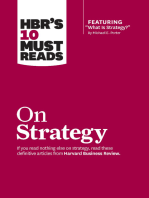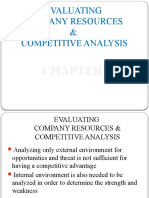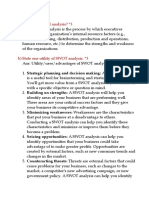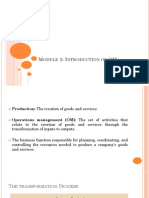0 ratings0% found this document useful (0 votes)
72 viewsSWOT Analysis: Internal To The Firm
SWOT Analysis: Internal To The Firm
Uploaded by
Ratih AflitaSWOT analysis involves analyzing a company's internal strengths and weaknesses as well as external opportunities and threats. It is important for companies to not only create lists in a SWOT analysis but to also align strategy with resources and opportunities, prioritize opportunities, and make difficult tradeoffs. A company's value chain consists of primary activities that create value for customers and support activities that facilitate the primary activities. Analyzing a company's value chain compared to competitors' allows a company to identify ways to reduce costs in activities performed internally, with suppliers, and in forwarding products to market.
Copyright:
© All Rights Reserved
Available Formats
Download as PPT, PDF, TXT or read online from Scribd
SWOT Analysis: Internal To The Firm
SWOT Analysis: Internal To The Firm
Uploaded by
Ratih Aflita0 ratings0% found this document useful (0 votes)
72 views9 pagesSWOT analysis involves analyzing a company's internal strengths and weaknesses as well as external opportunities and threats. It is important for companies to not only create lists in a SWOT analysis but to also align strategy with resources and opportunities, prioritize opportunities, and make difficult tradeoffs. A company's value chain consists of primary activities that create value for customers and support activities that facilitate the primary activities. Analyzing a company's value chain compared to competitors' allows a company to identify ways to reduce costs in activities performed internally, with suppliers, and in forwarding products to market.
Original Description:
swot value chain
Original Title
SWOT Value Chain Ch 4
Copyright
© © All Rights Reserved
Available Formats
PPT, PDF, TXT or read online from Scribd
Share this document
Did you find this document useful?
Is this content inappropriate?
SWOT analysis involves analyzing a company's internal strengths and weaknesses as well as external opportunities and threats. It is important for companies to not only create lists in a SWOT analysis but to also align strategy with resources and opportunities, prioritize opportunities, and make difficult tradeoffs. A company's value chain consists of primary activities that create value for customers and support activities that facilitate the primary activities. Analyzing a company's value chain compared to competitors' allows a company to identify ways to reduce costs in activities performed internally, with suppliers, and in forwarding products to market.
Copyright:
© All Rights Reserved
Available Formats
Download as PPT, PDF, TXT or read online from Scribd
Download as ppt, pdf, or txt
0 ratings0% found this document useful (0 votes)
72 views9 pagesSWOT Analysis: Internal To The Firm
SWOT Analysis: Internal To The Firm
Uploaded by
Ratih AflitaSWOT analysis involves analyzing a company's internal strengths and weaknesses as well as external opportunities and threats. It is important for companies to not only create lists in a SWOT analysis but to also align strategy with resources and opportunities, prioritize opportunities, and make difficult tradeoffs. A company's value chain consists of primary activities that create value for customers and support activities that facilitate the primary activities. Analyzing a company's value chain compared to competitors' allows a company to identify ways to reduce costs in activities performed internally, with suppliers, and in forwarding products to market.
Copyright:
© All Rights Reserved
Available Formats
Download as PPT, PDF, TXT or read online from Scribd
Download as ppt, pdf, or txt
You are on page 1of 9
SWOT analysis
Internal to the firm
Strengths
What a company is
good at
Some characteristic
that enhances
competitiveness
Weaknesses
What a company lacks
or does poorly
A disadvantageous
condition
External to the firm
Opportunities
Important profit
possibilities
Important competitive
advantages
Exploit a firms capabilities
Threats
Potential problems with
continued firm viability &
growth
Making 4 lists isnt enough:
what can the firm control?
Alignment analysis
How does overall strategy match resources &
opportunities?
How quickly does the firm need to correct for
weaknesses & environmental threats?
Prioritization & trade-off analysis
What matters most?
What must the firm give up to pursue prioritized
opportunities?
Does the firm have the backbone to make the hard
choices, and stick to them?
Core Competencies A Valuable Company Resource
A competence becomes a core competence when the
well-performed activity
is central to a companys competitiveness and
profitability
is recognized by and resides in the people who work
for the firm
represents a valuable competitive capability and
sustainable competitive asset
Examples??
Thus only 1-3 activities a firm performs are considered
core competences
The Concept of a Company Value Chain
Bottom line: cost control
A companys business consists of all activities
undertaken in designing, producing, marketing,
delivering, and supporting its product or service
A companys value chain consists of a linked set of
value-creating activities performed internally
The value chain contains two types of activities
Primary activities where most of
the value for customers is created
Support activities facilitate
performance of the primary activities
Representative Company Value Chain
Example: Value Chain Activities for a Bakery Goods
Maker
Primary Activities
Supply chain management
[most efficiently getting flour,
sugar, equipment, etc]
Recipe development and
testing
Mixing and baking
Packaging
Sales and marketing
Distribution
Support Activities
[indirect or
overhead
expenses]
Quality control
Human resource
management
Administration
Focuses on cross-company comparisons of how certain
activities are performed and costs associated with these
activities
Purchase of materials
Payment of suppliers
Management of inventories
Getting new products to market
Performance of quality control
Filling and shipping of customer orders
Training of employees
Processing of payrolls
Why is benchmarking here a good idea?
New business models: CDs vs digital downloads
Benchmarking Key Value Chain Activities
Cost competitiveness depends on how well a company
manages its value chain relative to how well
competitors manage theirs
When a companys costs are out-of-line, look to three
parts of industry value chain
1. Suppliers: can we buy it for less?
2. Internal activities: can we make it for less?
3. Forward channel allies: can we get it to market
for less?
Activities,
Costs, &
Margins of
Forward
Channel Allies
Internally
Performed
Activities,
Costs, &
Margins
Activities,
Costs, &
Margins of
Suppliers
Buyer/User
Value
Chains
Cost control as a competitive advantage
Limits of cost competitiveness & v.c.
As Porter tells us: there is only so much you can
squeeze out of the value chain without
innovation
Wal-Mart is hitting that wall
Cost containment, especially in supply chain,
eventually gets to the threshold
When threshold is reached what parts of the
v.c. can be re-done or removed completely?
Auto makers and robotics [removing humans]
No frills airlines vs legacy carriers [removing
labor unions, in-flight services, etc]
You might also like
- HBR's 10 Must Reads on Strategy (including featured article "What Is Strategy?" by Michael E. Porter)From EverandHBR's 10 Must Reads on Strategy (including featured article "What Is Strategy?" by Michael E. Porter)Rating: 4.5 out of 5 stars4.5/5 (26)
- Business Technology and Finance Question Bank 2019Document160 pagesBusiness Technology and Finance Question Bank 2019ngonhuvinhNo ratings yet
- MBA Notes: Course Notes from a Top MBA ProgramFrom EverandMBA Notes: Course Notes from a Top MBA ProgramRating: 4.5 out of 5 stars4.5/5 (4)
- Disney Balanced ScorecardDocument33 pagesDisney Balanced ScorecardAishah Abdul HalimNo ratings yet
- 15 PRO DUCT Quality ManualDocument42 pages15 PRO DUCT Quality ManualcoolmachineryNo ratings yet
- Chapter 10: CASE STUDY: Walmart and Amazon Duke It Out For E-Commerce SupremacyDocument25 pagesChapter 10: CASE STUDY: Walmart and Amazon Duke It Out For E-Commerce SupremacyMuhammad Alif HidayatullahNo ratings yet
- Porter Value Chain - InfraDocument5 pagesPorter Value Chain - InfraDebasish DeyNo ratings yet
- Coca Cola - Strategic AuditDocument7 pagesCoca Cola - Strategic AuditAmalia Ciatău100% (2)
- Chapter 5Document24 pagesChapter 5Roshani ShresthaNo ratings yet
- Strategy PPT Ch4Document56 pagesStrategy PPT Ch4Habtamu mamoNo ratings yet
- Value Chain AnalysisDocument17 pagesValue Chain AnalysisThakshila Devindi RathnayakaNo ratings yet
- Business StrategyDocument32 pagesBusiness StrategyMuskan KhanNo ratings yet
- Topic No. 09, 10 & 11Document6 pagesTopic No. 09, 10 & 11vivekNo ratings yet
- Strategic Group MapingDocument19 pagesStrategic Group MapingMitesh UnadkatNo ratings yet
- Logistics and Competitive Strategy, Competitive Advantage - Gaining Competitive Advantage Through LogisticsDocument12 pagesLogistics and Competitive Strategy, Competitive Advantage - Gaining Competitive Advantage Through LogisticsHemasri ChinnuNo ratings yet
- Strategic Management Chapter 4Document9 pagesStrategic Management Chapter 4Optimus PrimeNo ratings yet
- OF Strategic Planning ConceptsDocument61 pagesOF Strategic Planning ConceptsHarshal NaikNo ratings yet
- International Strategic Management Mid 2Document17 pagesInternational Strategic Management Mid 2Md HimelNo ratings yet
- Value Chain and Supply ChainDocument8 pagesValue Chain and Supply ChainJay SharmaNo ratings yet
- Value-Chain AnalysisDocument30 pagesValue-Chain AnalysisSheikh RubelNo ratings yet
- Value Chain AnalysisDocument24 pagesValue Chain Analysisminsatzz0% (1)
- Internal Analysis: Distinctive Competencies, Competitive Advantage and ProfitabilityDocument28 pagesInternal Analysis: Distinctive Competencies, Competitive Advantage and ProfitabilityArun Mathews JacobNo ratings yet
- The Concept of A Company Value Chain: BuyersDocument12 pagesThe Concept of A Company Value Chain: BuyersCarolyn ImaniNo ratings yet
- SM Unit-3Document11 pagesSM Unit-3Sagar PanditNo ratings yet
- Assignment On Strategic Managememt by UITSDocument14 pagesAssignment On Strategic Managememt by UITSMahtab BhuiyanNo ratings yet
- Organizational Appraisal Techniques: Ms Ashita ChadhaDocument29 pagesOrganizational Appraisal Techniques: Ms Ashita ChadhaAshita ChadhaNo ratings yet
- 1 Value Chain Analysis - SMIDocument10 pages1 Value Chain Analysis - SMIToto SubagyoNo ratings yet
- Strategic Management For STUDENTS.Document31 pagesStrategic Management For STUDENTS.mahnoorbitNo ratings yet
- Value Chain Analysis: Achieving Excellence in The Things That Really MatterDocument37 pagesValue Chain Analysis: Achieving Excellence in The Things That Really MatterSrivastav Gaurav100% (1)
- Value Chain Analysis (Benchmarking)Document6 pagesValue Chain Analysis (Benchmarking)zyzrb597kjNo ratings yet
- Strategic Planning Process 3 - Internal AnalysisDocument35 pagesStrategic Planning Process 3 - Internal Analysiskamasuke hegdeNo ratings yet
- Unit 2 SMDocument25 pagesUnit 2 SMakankshatyag7500No ratings yet
- Chapter-04 Evaluating A Company's Resources & Competitive PositionDocument25 pagesChapter-04 Evaluating A Company's Resources & Competitive PositionShahariar RiasatNo ratings yet
- M 1: I OM: Odule Ntroduction OFDocument36 pagesM 1: I OM: Odule Ntroduction OFShivam KencheNo ratings yet
- Unit IV Assessing The INTERNAL Environment of An OrganizationDocument44 pagesUnit IV Assessing The INTERNAL Environment of An Organizationmacs emsNo ratings yet
- What Is A Value Chain?: Marketing Management IntroDocument5 pagesWhat Is A Value Chain?: Marketing Management Introkatta swathiNo ratings yet
- Chapter 4 Internal AnalysisDocument18 pagesChapter 4 Internal AnalysisAbhi ShekNo ratings yet
- BL Finals PPT 2Document38 pagesBL Finals PPT 2SHEINNA MARI TANTE0% (1)
- Marketing Management Chapter 2Document6 pagesMarketing Management Chapter 2Fatima MalikNo ratings yet
- What's Value Chain Analysis? How Is It Carried Out? Describe Its Role in Strategic Cost AnalysisDocument15 pagesWhat's Value Chain Analysis? How Is It Carried Out? Describe Its Role in Strategic Cost AnalysisVivek SolankiNo ratings yet
- Value Chain Analysis.1Document16 pagesValue Chain Analysis.1shashi05579No ratings yet
- Answer: No. Supply Chain and Supply Chain Management Are Not SameDocument2 pagesAnswer: No. Supply Chain and Supply Chain Management Are Not SameM FatihaNo ratings yet
- Competitive Profile MatrixDocument4 pagesCompetitive Profile MatrixDikshit KothariNo ratings yet
- Value Chain AnalysisDocument9 pagesValue Chain AnalysisRabbani MominNo ratings yet
- Benchmarking Is An Essential Part of TQM For Continuous ImprovementDocument46 pagesBenchmarking Is An Essential Part of TQM For Continuous Improvementwaqasrashid75No ratings yet
- Developing Astrategic Business PlanDocument74 pagesDeveloping Astrategic Business PlannidalitNo ratings yet
- Value Chain Analysis: Primary ActivitiesDocument5 pagesValue Chain Analysis: Primary ActivitiesSmiely SafeeNo ratings yet
- Generic Value ChainDocument4 pagesGeneric Value ChainKhushi ChauhanNo ratings yet
- ENTREP - What Is A Value ChainDocument4 pagesENTREP - What Is A Value Chainandrei cabacunganNo ratings yet
- Capability AnalysisDocument5 pagesCapability AnalysisAnn NdunguNo ratings yet
- Value Chain Analysis and Five Force AnalysisDocument22 pagesValue Chain Analysis and Five Force AnalysisAli Hassan50% (2)
- Accounting Information Systems Study NotesDocument24 pagesAccounting Information Systems Study NotesAlexander TrovatoNo ratings yet
- He Industry Value Chain: Value Chains and Business StrategyDocument6 pagesHe Industry Value Chain: Value Chains and Business StrategyBabu VinothkumarNo ratings yet
- Strategic Management 3-4Document16 pagesStrategic Management 3-4Semih EminiNo ratings yet
- Welcome TO Entrepreneurship Class: Ma. Annabelle A. LinoboDocument38 pagesWelcome TO Entrepreneurship Class: Ma. Annabelle A. LinoboCla Rence OliverosNo ratings yet
- 202004032250571599rajni Gupta Com Value Chain AnalysisDocument8 pages202004032250571599rajni Gupta Com Value Chain Analysisaliziadk2023No ratings yet
- 4 Operations SrtrategyDocument37 pages4 Operations SrtrategyRosni ShahNo ratings yet
- Competitive Advantage Version2Document20 pagesCompetitive Advantage Version2Kathita GoelNo ratings yet
- Meenabazar 221117Document5 pagesMeenabazar 221117sodalime01No ratings yet
- Nilam JadhavDocument16 pagesNilam JadhavPooja ChavanNo ratings yet
- PARTS AnalysisDocument6 pagesPARTS AnalysisAshish BhakuniNo ratings yet
- 54268-The Balanced ScorecardDocument33 pages54268-The Balanced ScorecardnissreenbarakatNo ratings yet
- Michael Porter's Value Chain: Unlock your company's competitive advantageFrom EverandMichael Porter's Value Chain: Unlock your company's competitive advantageRating: 4 out of 5 stars4/5 (1)
- Marketing Management Full Notes Mba PDFDocument268 pagesMarketing Management Full Notes Mba PDFKollol Deb100% (1)
- Group 1 mkt318m Group Assignment ReportDocument24 pagesGroup 1 mkt318m Group Assignment Reportduynmhs179011No ratings yet
- Wilkerson ABC Costing Case StudyDocument8 pagesWilkerson ABC Costing Case StudyParamjit Singh100% (4)
- Lecture 1 - Strategic Leadership - Managing The Strategy-Making Process For Competitive AdvantageDocument30 pagesLecture 1 - Strategic Leadership - Managing The Strategy-Making Process For Competitive Advantagejefribasiuni1517No ratings yet
- A Study of Customer Expectation and Satisfaction of Life Insurance in IndiaDocument18 pagesA Study of Customer Expectation and Satisfaction of Life Insurance in IndiaJaswinder SinghNo ratings yet
- Advanced Certificate in Procurement and Supply Operations: Unit Content GuideDocument22 pagesAdvanced Certificate in Procurement and Supply Operations: Unit Content Guidebahadoor22i5583No ratings yet
- My PresentationDocument42 pagesMy PresentationImran HossanNo ratings yet
- Characteristics of Consumer BehaviorDocument5 pagesCharacteristics of Consumer BehaviorSahil Khanna100% (1)
- Entrepreneur'S Field or Expertise: Social EntrepreneursDocument2 pagesEntrepreneur'S Field or Expertise: Social EntrepreneursAira SoquinoNo ratings yet
- CV VivekDocument3 pagesCV Vivekshakya12No ratings yet
- Brand Israel Research Paper AbstractDocument3 pagesBrand Israel Research Paper AbstractRommeyHassman0% (1)
- SCMPE Notes by Vaibhav BansalDocument37 pagesSCMPE Notes by Vaibhav Bansalhiral.salarpuriaNo ratings yet
- JugaadDocument11 pagesJugaadfaradayNo ratings yet
- Lembar Kerja Peserta Didik (LKPD)Document10 pagesLembar Kerja Peserta Didik (LKPD)miniNo ratings yet
- Jeopardy Game 2008Document33 pagesJeopardy Game 2008Heidi100% (2)
- Chapter 17 Direct and Online MarketingDocument35 pagesChapter 17 Direct and Online MarketingGautham KarunaNo ratings yet
- Syllabus & Sap MM5003 - : Marketing ManagementDocument19 pagesSyllabus & Sap MM5003 - : Marketing ManagementTumpal SimatupangNo ratings yet
- TiVo in 2002Document18 pagesTiVo in 2002Gaurav Agarwal100% (1)
- Encyclopædia Britannica's President On Killing Off A 244-Year-Old ProductDocument4 pagesEncyclopædia Britannica's President On Killing Off A 244-Year-Old ProductJeng Jeng De Castro100% (1)
- 1.the World of WorkDocument6 pages1.the World of Workana fonsecaNo ratings yet
- CeraDocument32 pagesCeraRohit ThapliyalNo ratings yet
- Thesis 2Document50 pagesThesis 2EngrAbeer ArifNo ratings yet
- Glossier Final ProjectDocument15 pagesGlossier Final Projectapi-479314637No ratings yet
- Media PlanningDocument40 pagesMedia PlanningProfessor Sameer Kulkarni99% (69)
- Modes of Entry Into International BusinessDocument25 pagesModes of Entry Into International BusinessKHUSHI MEHTANo ratings yet
- (Mall) 9.9 & 10.10 2024 - Pitch DeckDocument88 pages(Mall) 9.9 & 10.10 2024 - Pitch Decksalmasalsabil073No ratings yet

























































































